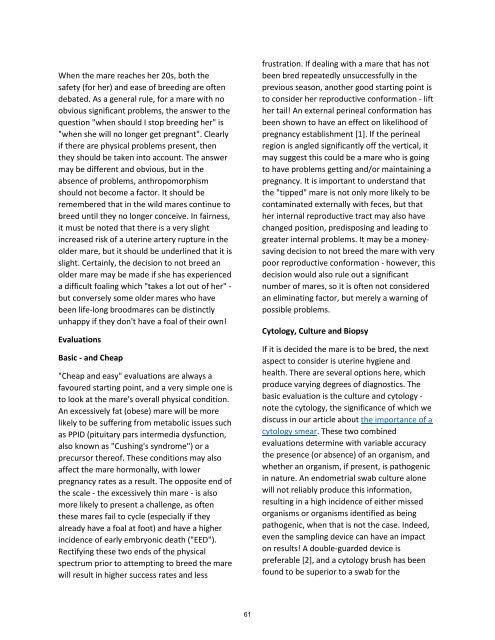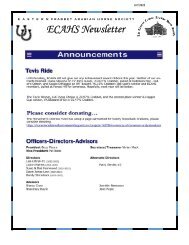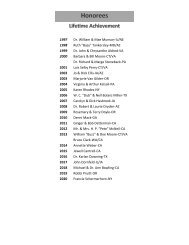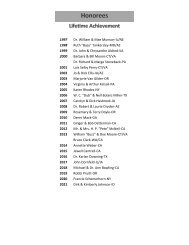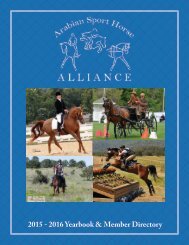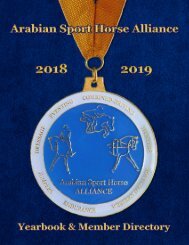Arabian Sport Horse Alliance 2017-2018 Directory & Yearbook
Annual publication of the Arabian Sport Horse Alliance, Inc. Honoree Articles, Award Listings, Photo Galleries, Youth Member Spotlights, Stallion Pages, Farm Profiles, Educational Articles, and more.....
Annual publication of the Arabian Sport Horse Alliance, Inc.
Honoree Articles, Award Listings, Photo Galleries, Youth Member Spotlights, Stallion Pages, Farm Profiles, Educational Articles, and more.....
You also want an ePaper? Increase the reach of your titles
YUMPU automatically turns print PDFs into web optimized ePapers that Google loves.
When the mare reaches her 20s, both the<br />
safety (for her) and ease of breeding are often<br />
debated. As a general rule, for a mare with no<br />
obvious significant problems, the answer to the<br />
question "when should I stop breeding her" is<br />
"when she will no longer get pregnant". Clearly<br />
if there are physical problems present, then<br />
they should be taken into account. The answer<br />
may be different and obvious, but in the<br />
absence of problems, anthropomorphism<br />
should not become a factor. It should be<br />
remembered that in the wild mares continue to<br />
breed until they no longer conceive. In fairness,<br />
it must be noted that there is a very slight<br />
increased risk of a uterine artery rupture in the<br />
older mare, but it should be underlined that it is<br />
slight. Certainly, the decision to not breed an<br />
older mare may be made if she has experienced<br />
a difficult foaling which "takes a lot out of her" -<br />
but conversely some older mares who have<br />
been life-long broodmares can be distinctly<br />
unhappy if they don't have a foal of their own!<br />
Evaluations<br />
Basic - and Cheap<br />
"Cheap and easy" evaluations are always a<br />
favoured starting point, and a very simple one is<br />
to look at the mare's overall physical condition.<br />
An excessively fat (obese) mare will be more<br />
likely to be suffering from metabolic issues such<br />
as PPID (pituitary pars intermedia dysfunction,<br />
also known as "Cushing's syndrome") or a<br />
precursor thereof. These conditions may also<br />
affect the mare hormonally, with lower<br />
pregnancy rates as a result. The opposite end of<br />
the scale - the excessively thin mare - is also<br />
more likely to present a challenge, as often<br />
these mares fail to cycle (especially if they<br />
already have a foal at foot) and have a higher<br />
incidence of early embryonic death ("EED").<br />
Rectifying these two ends of the physical<br />
spectrum prior to attempting to breed the mare<br />
will result in higher success rates and less<br />
frustration. If dealing with a mare that has not<br />
been bred repeatedly unsuccessfully in the<br />
previous season, another good starting point is<br />
to consider her reproductive conformation - lift<br />
her tail! An external perineal conformation has<br />
been shown to have an effect on likelihood of<br />
pregnancy establishment [1]. If the perineal<br />
region is angled significantly off the vertical, it<br />
may suggest this could be a mare who is going<br />
to have problems getting and/or maintaining a<br />
pregnancy. It is important to understand that<br />
the "tipped" mare is not only more likely to be<br />
contaminated externally with feces, but that<br />
her internal reproductive tract may also have<br />
changed position, predisposing and leading to<br />
greater internal problems. It may be a moneysaving<br />
decision to not breed the mare with very<br />
poor reproductive conformation - however, this<br />
decision would also rule out a significant<br />
number of mares, so it is often not considered<br />
an eliminating factor, but merely a warning of<br />
possible problems.<br />
Cytology, Culture and Biopsy<br />
If it is decided the mare is to be bred, the next<br />
aspect to consider is uterine hygiene and<br />
health. There are several options here, which<br />
produce varying degrees of diagnostics. The<br />
basic evaluation is the culture and cytology -<br />
note the cytology, the significance of which we<br />
discuss in our article about the importance of a<br />
cytology smear. These two combined<br />
evaluations determine with variable accuracy<br />
the presence (or absence) of an organism, and<br />
whether an organism, if present, is pathogenic<br />
in nature. An endometrial swab culture alone<br />
will not reliably produce this information,<br />
resulting in a high incidence of either missed<br />
organisms or organisms identified as being<br />
pathogenic, when that is not the case. Indeed,<br />
even the sampling device can have an impact<br />
on results! A double-guarded device is<br />
preferable [2], and a cytology brush has been<br />
found to be superior to a swab for the<br />
61


